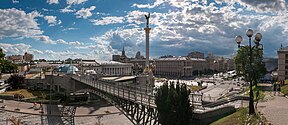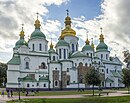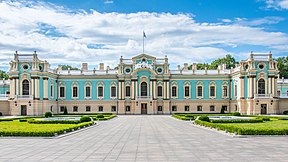
Kyiv
Capital of Ukraine / From Wikipedia, the free encyclopedia
Dear Wikiwand AI, let's keep it short by simply answering these key questions:
Can you list the top facts and stats about Kiev?
Summarize this article for a 10 year old
Kyiv (also Kiev)[lower-alpha 1] is the capital and most populous city of Ukraine. It is in north-central Ukraine along the Dnieper River. As of 1 January 2022, its population was 2,952,301,[5] making Kyiv the seventh-most populous city in Europe.[11] Kyiv is an important industrial, scientific, educational, and cultural center in Eastern Europe. It is home to many high-tech industries, higher education institutions, and historical landmarks. The city has an extensive system of public transport and infrastructure, including the Kyiv Metro.
Kyiv
Kiev | |
|---|---|
| Nickname: | |
| Anthem: Yak tebe ne liubyty, Kyieve mii! | |
 Interactive map of Kyiv | |
| Coordinates: 50°27′00″N 30°31′24″E | |
| Country | Ukraine |
| Municipality | Kyiv |
| Founded | 482 CE (officially)[2] |
| Named for | Kyi |
| City council | Kyiv City Council |
| Districts | |
| Government | |
| • Mayor and Head of City State Administration | Vitali Klitschko[3][4] |
| Area | |
| • Capital city and city with special status | 839 km2 (324 sq mi) |
| Elevation | 179 m (587 ft) |
| Population (1 January 2021) | |
| • Capital city and city with special status | |
| • Rank | 1st in Ukraine 7th in Europe |
| • Density | 3,299/km2 (8,540/sq mi) |
| • Metro | 3,475,000[6] of the Kyiv metropolitan area |
| Demonym(s) | Kyivan,[7][8] Kievan[9] |
| GDP | |
| • Total | ₴1.276 trillion (€30.3 billion) |
| • Per capita | ₴431,616 (€10,200) |
| Time zone | UTC+2 (EET) |
| • Summer (DST) | UTC+3 (EEST) |
| Postal code | 01xxx–04xxx |
| Area code | +380 44 |
| ISO 3166 code | UA-30 |
| Vehicle registration plate | AA, KA (before 2004: КА, КВ, КЕ, КН, КІ, KT) |
| FIPS code | UP12 |
| Website | kyivcity.gov.ua |
The city's name is said to derive from the name of Kyi, one of its four legendary founders. During its history, Kyiv, one of the oldest cities in Eastern Europe, passed through several stages of prominence and obscurity. The city probably existed as a commercial center as early as the 5th century. A Slavic settlement on the great trade route between Scandinavia and Constantinople, Kyiv was a tributary of the Khazars,[12] until its capture by the Varangians (Vikings) in the mid-9th century. Under Varangian rule, the city became a capital of Kievan Rus', the first East Slavic state. Completely destroyed during the Mongol invasions in 1240, the city lost most of its influence for the centuries to come. Coming under Lithuania, then Poland and then Russia, the city would grow from a frontier market into an important centre of Orthodox learning in the sixteenth century, and later of industry, commerce, and administration by the ninenteenth.[1]
The city prospered again during the Russian Empire's Industrial Revolution in the late 19th century. In 1918, when the Ukrainian People's Republic declared independence from the Russian Republic after the October Revolution there, Kyiv became its capital. From the end of the Ukrainian-Soviet and Polish-Soviet wars in 1921, Kyiv was a city of the Ukrainian SSR, and made its capital in 1934. The city suffered significant destruction during World War II but quickly recovered in the postwar years, remaining the Soviet Union's third-largest city.
Following the collapse of the Soviet Union and Ukrainian independence in 1991, Kyiv remained Ukraine's capital and experienced a steady influx of ethnic Ukrainian migrants from other regions of the country.[13] During the country's transformation to a market economy and electoral democracy, Kyiv has continued to be Ukraine's largest and wealthiest city. Its armament-dependent industrial output fell after the Soviet collapse, adversely affecting science and technology, but new sectors of the economy such as services and finance facilitated Kyiv's growth in salaries and investment, as well as providing continuous funding for the development of housing and urban infrastructure. Kyiv emerged as the most pro-Western region of Ukraine; parties advocating tighter integration with the European Union dominate during elections.









